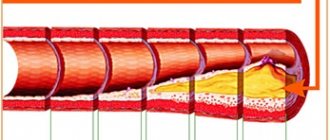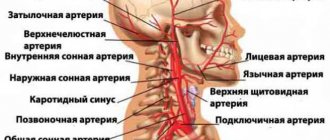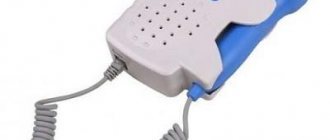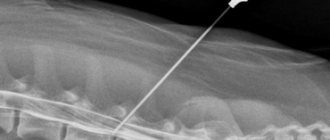MRI of the vessels of the brain and neck is prescribed to patients to identify existing pathological processes. Tomography is rightfully considered the most highly accurate type of examination. Diagnosis of soft tissue disease through other measures is very problematic.
Thus, ultrasound examination is considered a low-informative procedure, which is used for this purpose in rare cases. For example, when for one reason or another it is not possible to undergo an MRI of the vessels and arteries of the neck or brain, and it is advisable to perform a computed tomography scan only to identify tumors. In addition, CT scanning is associated with radiation exposure to the patient’s body, so scanning cannot be called completely safe and cannot be carried out without compelling reasons.
The main advantages of MRI diagnostics of brain and neck vessels
The high accuracy of MRI of brain and neck vessels is far from the only advantage of scanning. This may also include:
- absolute safety for the health of the subject;
- ease of examination;
- a small number of prohibitions and contraindications for undergoing scanning;
- a real possibility of identifying a pathological process at the very initial stage of its occurrence;
- Possibility of scanning an unlimited number of times.
As a rule, an examination of the vascular system of the brain is carried out together with an MRI of the vessels and arteries of the neck.
Carrying out two types of diagnostics simultaneously is determined by the fact that normal blood flow in the brain can only be ensured if there are no disturbances in blood circulation in the neck. For example, improper blood circulation as a result of mechanical injury in the neck area in most cases leads to oxygen starvation of the brain, which can cause the death of the victim. This leads to the logical conclusion that it is not advisable to conduct exclusively magnetic resonance imaging of brain vessels.
The scan allows specialists to draw conclusions based on 3D images of blood supply in a particular part of the brain.
MRI of cerebral vessels is a unique diagnostic method that detects diseases of the veins and arteries, so no type of examination can be compared with tomography due to its significantly low information content.
Due to layer-by-layer scanning and high-quality images, the likelihood of error during diagnosis is practically reduced to zero.
Is magnetic resonance imaging done for atherosclerosis?
The cause of stroke is atherosclerosis. The disease is chronic in nature, the cause is the formation of defects on the walls with filling with dissolved compounds of fat metabolism. Blockage of the artery is accompanied by a deficiency of nutrients to the organs, which are supplied through damaged vessels.
A serious illness is the accumulation of platelets inside the vascular cavity (thrombosis). It appears due to blood thinning, which leads to the formation of blood clots that reduce the patency inside the veins. During an MRI examination of the circulatory system of the head, a special substance penetrates into the vessels, giving them a contrasting color on magnetic resonance imaging, which makes it possible to see morphological and functional deviations in the images. Magnetic resonance imaging is performed not only to detect a defect located inside the vessels/tissues, but also to understand the cause of the generation and destruction of head cells. After diagnosis, it is easier to make a correct diagnosis.
MR imaging reveals aneurysms located on the walls of blood vessels due to their deformation after disturbances in the blood supply. Vascular abnormalities of the veins/arteries will lead to a lack of blood supply to the brain tissue. Most often, aneurysms are diagnosed in patients with high blood pressure or atherosclerosis. When examining the vascular system, a disease is detected that can also be detected during classical MRI - stroke, even in the initial stages of development. Thanks to the use of a contrast enhancer, the blood supply channels are clearly visible.
Tomograms visualize the degree of filling of veins and arteries with blood, identifying the paths of blood movement around pathological obstacles. The procedure will be useful for studying different types of formations. Benign tumors, the most common of which are cystic inclusions of the brain, usually appear as a result of complex injuries.
The result of a bruise or deformation of the skull is damage to the circulatory system inside the head, which leads to the death of brain cells and the progression of ischemia. The malignant nature of the formation is clearly visible on tomograms; when performing an ultrasound or x-ray, it is not possible to determine the nature of the pathology.
Any cancer inside the head causes the tissue to become deformed (compressed). Compared to other parts of the body, where its development leads to stretching of soft tissues, the head is surrounded by hard bone tissue of the skull. If the tumor is not removed in a timely manner, death is inevitable. The results of tomography make it possible not only to take into account all the features of the disease, but also to select the only correct treatment and predict the subsequent development of the disease.
Indications for MRI of head and neck vessels
As a rule, such an examination is not prescribed by specialists for no apparent reason. Reasons for prescribing a scan may include:
- ischemic disease;
- very frequent headaches;
- the appearance of dizziness;
- sensation of ringing and noise in the ears;
- vegetative-vascular dystonia.
After the scan, the doctor evaluates the resulting images, where it is possible to clearly visualize the blood supply to various areas of the brain and neck.
MRI diagnostic services at CELT
| Service name | Price in rubles |
| MRI of the brain | 6 000 |
| MR angiography of cerebral vessels | 4 000 |
| MRI of the brain and pituitary gland with intravenous contrast agent | 14 000 |
All services
Make an appointment through the application or by calling +7 +7 We work every day:
- Monday—Friday: 8.00—20.00
- Saturday: 8.00–18.00
- Sunday is a day off
The nearest metro and MCC stations to the clinic:
- Highway of Enthusiasts or Perovo
- Partisan
- Enthusiast Highway
Driving directions
What does the scan reveal?
It is advisable to conduct MRI of the vessels and arteries of the neck to identify many diseases and pathological processes, which include:
- cerebrovascular accident due to the presence of atherosclerotic plaques on the inner walls of blood vessels;
- received injuries to the head and neck;
- brain infections of any etiology;
- life-threatening conditions due to brain damage (for example, cerebral infarction);
- any neoplasms;
- pathological structure of the vascular system of the brain;
- multiple sclerosis.
What is an MRI of the brain?
MRI of the brain is an absolutely painless, non-invasive (i.e., does not require “penetrating” procedures) way of studying a number of diseases of the nervous system. MRI of the head is based on the property of the nuclei of hydrogen atoms to be excited under the influence of electromagnetic waves inside an intense magnetic field. The obtained data is visualized using modern computer technology.
An MRI of a child’s brain in Moscow, as well as an examination of an adult, allows us to determine the cause of many diseases - deviations in the development of this organ, various pathologies and disturbances in its functioning.
MRI of the brain - 6,000 rubles.
MR tomography of the brain and pituitary gland with intravenous administration of a contrast agent - 14,000 rubles.
MR angiography of neck vessels - 4,000 rubles.
MR angiography of cerebral vessels - 4,000 rubles.
15-45 minutes
(duration of procedure)
Indications
- traumatic brain injuries with possible fracture of bones or internal structures;
- suspicions of multiple sclerosis (the main symptoms are memory impairment, loss of concentration, severe forgetfulness and disorientation in space);
- suspicions of cancer, cyst, tumor or concussion (frequent dizziness, prolonged weakness, headaches, double vision, etc.);
- stroke and heart attack to assess the extent of brain damage;
- encephalitis, encephalopathy, atrophy;
- epilepsy and other diseases.
Contraindications
MRI diagnostics is undesirable when:
- decompensated heart failure;
- early stages of pregnancy;
- tattoos with dyes containing iron;
- using metal braces;
- artificial walls of blood vessels and heart valves.
Attention! MRI of the brain, vessels of the head and neck is strictly prohibited if:
- installed pacemaker;
- large metal implants;
- hemostatic clips of cerebral vessels;
- electronic or ferromagnetic middle ear implants.
Contraindications for examination
Despite the fact that MRI of the head and neck vessels is an absolutely safe diagnosis, there are still some contraindications for its use. If we look at it as a whole, they are not at all different from those contraindications that apply to scanning other parts of the body.
First of all, MRI of cerebral vessels is unacceptable for people with metal objects in their body. Any implants, stimulators, prostheses act as contraindications. The exception is products made of titanium. After the doctor is aware of the presence or absence of such objects in the body, the patient will be allowed to undergo the examination or will be refused. In this case, the patient must provide the specialist with appropriate documentary evidence of his words. The type of material from which a particular implant is made is recorded in a special certificate issued after the surgical intervention.
Another contraindication to MRI of the vessels of the head and neck is scanning using contrast for women carrying a child. The chemical substance, despite its relative safety for an adult, can cause irreparable harm to a developing fetus, which is why such a ban is due.
The use of contrast is unacceptable regardless of the duration of pregnancy, as well as during the lactation period. At the same time, MRI of the vessels and arteries of the neck without contrast enhancement is quite acceptable for pregnant women in the 2nd and 3rd trimesters, when the fetus has developed all vital organs and systems.
Is it possible to influence the reliability of the data obtained?
No special preparation is required for an MRI examination of the brain. The patient can continue to take all of their usual medications and does not need to make any changes to their diet or lifestyle. However, following some recommendations will allow you to get an accurate result.
If there is an indication for MRI, the patient must obtain a referral for the study from his attending physician. An extract from the outpatient card or medical history of the inpatient is also required.
If the patient has previously had an MRI of the brain in Moscow or any other city, then it is necessary to submit previous images.
Immediately before the tomography, you need to undergo a general examination and consult a specialist.
Of particular importance are the additional information provided to the radiologist:
- clinical picture (preliminary examination results;
- symptoms, complaints, treatment received, presence of chronic diseases, etc.);
- information about metal objects located in the body (prostheses, implant, pacemaker, etc.);
- information about previous injuries, previous operations and all serious reasons for visiting doctors.
Limitations for MRI of brain and neck vessels
It is not always possible to conduct tomography for people with mental illness, patients with uncontrolled movements of the limbs, as well as people with a fear of being in a confined space. Often, scanning of such patients is carried out in a state of medicated sleep, since otherwise it is impossible to carry out a diagnosis.
It is especially difficult to perform MRI of cerebral vessels in patients on mechanical ventilation. Not every medical institution has specialists who can take on such responsibility.
Very often, tomography is performed under anesthesia and in young children. It is very difficult for children to remain immobilized throughout the entire examination period, and under anesthesia, the scanning is very calm for both them and the doctors. Another advantage of using anesthesia is that young patients will not experience any stress and will not have negative memories.
How to do an MRI of the brain with contrast
A contrast study of the brain is carried out as follows:
1. Indications, contraindications and procedures for carrying out the procedure at the Northern Capital Medicine diagnostic center are no different from those for MRI of the brain without contrast.
2. The only difference is the introduction of contrast into the patient’s body (Omniscan).
3. The first series of images is taken without introducing the Omniscan. Then the laboratory assistant administers the drug intravenously using an injector. After the Omniscan is administered, a second series of images is taken.
The volume of the administered drug depends on the patient's weight. For body weight up to 20 kg, 10 ml is administered (the cost of contrast is 2400 rubles); 70-90 kg - 15 ml (3200 rub.); over 90 kg - 20 ml (4400 RUR). The use of contrast increases the duration of the study by 15-20 minutes.
Preparation for MRI of brain and neck vessels
Many patients before undergoing MRI of cerebral vessels are worried that they will have to comply with some strict restrictions before scanning. Such speculation is completely unfounded. There is no need to carry out any preparatory measures on the eve of the diagnosis, which is a huge advantage of magnetic resonance imaging. As discussed above, the most important condition is that the patient should not have any metal objects in his body, and it is also unacceptable to undergo scanning in clothes that have rivets, buttons, zippers and other metal parts. It is recommended to change your clothes to looser or hospital clothes.
Patients who have been scheduled to undergo an MRI of cerebral vessels using contrast should not eat any food on the day of the examination. The scanning itself takes place very quickly (usually it does not take more than 15 minutes), so no unpleasant sensations should arise during this time.
How to prepare for the procedure?
Magnetic resonance imaging does not require special preparation. Some clinics give patients advice on what to eat the night before and on the day of the test. If your doctor does not advise you to do so, you can eat and take your medications as usual.
Before the procedure at the Medica24 International Clinic, you will be consulted by a doctor. If you suffer from any diseases, allergies, or have recently undergone surgery, you must inform your doctor about this. If a patient has kidney problems, blood tests may be needed to evaluate kidney function. In some cases, radiography may be required to check whether there are metal implants or foreign bodies in the patient's body.
When going for the procedure, you do not need to wear any metal jewelry - they will still have to be removed before the study, because a strong magnetic field is used during MRI. Do not wear clothes with metal buttons or fasteners.
How is MRI of the vessels of the brain and neck performed?
Diagnosis is carried out using a special device - a magnetic resonance imaging scanner, which looks like a large tunnel from the outside. Before the scan begins, the patient is explained how to behave correctly inside the device, namely:
- It is prohibited to bring any gadgets with you;
- it is unacceptable to make any, even the most insignificant movements;
- You cannot make movements with your mouth (for example, try to speak).
Of course, in exceptional cases, when the patient feels significant changes in well-being during an MRI of the vessels and arteries of the neck or brain (which happens extremely rarely and is most likely caused by fear of undergoing diagnostics), he will always be able to contact the medical staff using a speaker and report changes in your health. If there are compelling reasons, the doctor may decide to interrupt the procedure.
The patient is also informed that there is no need to be afraid of the characteristic sounds of a working tomograph - this is a completely natural phenomenon. The doctor will ask how you are feeling and suggest taking sedatives if necessary.
If MRI of brain vessels needs to be performed using contrast, the doctor will definitely ask about the presence of allergic manifestations to medications.
The scanning takes place without the use of radiation exposure, which means it is completely harmless to the patient. Due to the fairly short examination time, patients in most cases tolerate it well, because the likelihood of panic attacks during an MRI of the vessels and arteries of the neck or brain is minimized.
In what cases is MRI of the brain performed? Types of research.
Typically, patients are referred for brain MRI by neurologists and neurosurgeons. You can, of course, sign up for the study yourself, but if you are bothered by certain symptoms, it is better to first visit a doctor, he will prescribe the necessary types of diagnostics.
Magnetic resonance imaging helps diagnose many diseases of the central nervous system:
- hydrocephalus (“dropsy of the brain”);
- various developmental anomalies;
- infectious processes;
- causes of seizures in patients with epilepsy;
- tumors of the brain and spinal cord;
- intracranial hemorrhages;
- causes of visual and hearing impairment;
- multiple sclerosis, Alzheimer's disease, Parkinson's disease;
- arterial aneurysms, arterial occlusions (blockages), venous thrombosis.
Get a consultation with a doctor
Message sent!
expect a call, we will contact you shortly
MRI of the cerebral arteries is performed with contrast. A special drug is injected intravenously, which will “paint” the blood vessels and allow them to be clearly outlined in the photographs.
Using functional magnetic resonance imaging, you can evaluate the activity of different areas of the brain. This helps to obtain valuable information in a number of pathologies, such as neurodegenerative diseases.
Decoding the received data
As soon as the examination is completed, the patient will be able to leave the office to await the conclusion. Based on the images obtained, the radiologist will make a diagnosis and write a report. It can be issued both in paper and electronic form on any digital medium. The patient must show the obtained images and the report to the doctor who has been prescribed a referral for magnetic resonance imaging.
In the event that the tomography was carried out on your own initiative, you need to contact the specialist who is involved in the treatment of the identified pathology. It is important to remember that the earlier the correct treatment is started, the higher the likelihood that it will be successful and will not take long.
MRI of the brain with contrast - what is it?
MRI of the brain with contrast is a technique that allows you to increase the diagnostic value of the method by introducing special contrast agents (containing gadolinium).
What is contrast used for?
Gross pathologies that disrupt the anatomy of the brain are easily detected on MRI images taken under normal conditions. But this doesn't always happen. Inflammatory processes, some types of tumors, hemorrhages and other diseases are not accompanied by changes in tissue contrast. They are difficult to distinguish on ordinary photographs, since there is no clear boundary between pathology and normality. In such cases, contrast agents are used.
Mechanism of action
Gadolinium, which is part of the contrast, has 7 free electrons in its orbits. Getting into the intercellular space, it forms weak bonds with the hydrogen of water molecules. This leads to a strong decrease in the T1 and T2 relaxation times for the tissues under study. But since gadolinium does not penetrate the blood-brain barrier (the boundary between the bloodstream and brain cells), its direct administration does not affect tissue contrast.
The photo on the left is without contrast. The image on the right with the use of contrast clearly visualizes the area of hemorrhage during a stroke.
Inflammation, infections, hemorrhages, death of brain cells, tumors and metastases lead to disruption of the blood-brain barrier, resulting in gadolinium freely penetrating into pathologically altered tissues. A sharp reduction in relaxation time in T1 and T2 modes for this area, under the influence of gadolinium, is accompanied by an increase in tissue contrast between healthy and altered areas of the brain.
This difference is clearly reflected in the resulting image of the organs being examined, which makes it possible to diagnose certain diseases with greater accuracy. The technique is used for MRI of head vessels with contrast to improve tissue contrast between brain tissue and vascular bed.
Valuable information is provided by the parameters of the rate and degree of accumulation of contrast in the tissues of the tumor. Benign tumors slowly absorb and release moderate amounts of contrast. Malignant neoplasms, due to their developed vascular network, quickly capture large amounts of contrast and also quickly release it. Thanks to this, it is possible to preliminarily determine the nature of the tumor.
It is a misconception that contrast increases the overall quality (brightness, contrast, clarity, or resolution) of an image. The quality of the image depends on the strength of the magnetic field and the sequence of radio frequency signals used. Contrast accumulates only in pathologically changed areas of the brain and cannot affect the clarity of the image.
Potential Risks
Carrying out magnetic resonance imaging does not involve any risks for the patient. Due to the fact that the subject’s body is securely fixed with special straps, throughout the entire scanning period the likelihood of any injury is reduced to zero.
However, the possibility of unpleasant sensations due to being inside the tomograph cannot be completely excluded. The patient may experience increased heart rate, dizziness, and a feeling of tightness in the sternum, which has a psychosomatic cause. Therefore, you should not ignore the doctor’s suggestion to take sedatives before starting the examination.











